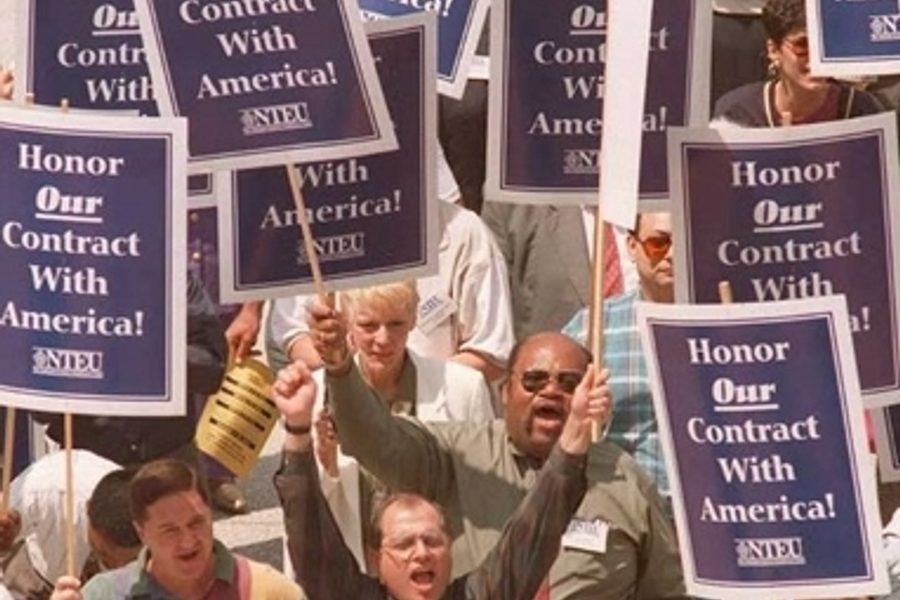
Some of the nation’s largest municipalities face huge pension shortfalls that could hinder local and state governments’ ability to operate, according to a new study. Around the country, unions are facing mounting pressure to accept benefit rollbacks — and many already have.
“The Crisis in Local Government Pensions in the United States,” released Tuesday by Northwestern University, says that cities and counties across the country are liable for $574 billion in pension plans in addition to an estimated $3 trillion in unfunded state pensions. The grim result: U.S. households owe on average $15,000 each to former and current municipal workers. The numbers are even higher in places like Chicago, where the average is almost $42,000.
The findings come as many states have began or are strongly considering pension rollbacks, setting the stage for tenuous negotiations with labor unions representing the 7.9 million public-sector workers. Many discussions have already begun with changes to agreements that include increasing the retirement age, furloughs, pension cuts and freezes. With elections and budget crises looming, public unions have entered the spotlight once again, providing much fodder for critics who say labor costs are above budget levels.
The research, led by academics from Northwestern University and the University of Rochester, is based on an analysis of pension plans in 50 major cities covering 2 million local government workers — roughly two-thirds of municipal employees.
According to the Associated Press, in the past two years, more than 19 states have either considered or instituted pension cutbacks for current and new hires. Six major cities — Philadelphia, Boston, Chicago, Cincinnati, Jacksonville and St. Paul — can only pay for pensions through 2020, the study’s authors say.
“The fact that there is such a large burden of public employee pensions concentrated in urban metropolitan areas threatens the long-run economic viability of these cities, as residents can potentially move elsewhere to escape the situation,” the report said.
Concession pressure
As a result, public sector unions, which represent 37.4 percent of the civil servant workforce, have faced increasing pressure to accept the concessions across the country.
Public officials have cited the public unions’ unwillingness to make cuts as a source of the budget crisis, but labor groups have maintained that the recession and Wall Street have contributed to poor pension results.
Indeed, while public sector criticism mounts, Wall Street compensation is on its way to top last year’s record with executive payments totaling $144 billion this year, the Wall Street Journal says. And not to mention the private sector has their own pension problems. U.S. corporations lost $900 billion from October 2007 to October 2008, according to a Boston College study.
It isn’t clear that public sector unions are contributing to financial shortfalls either: states with pension problems vary from heavily unionized regions to those with little representation.
And the rhetoric has also overstated how much they are straining municipal finances. A seperate study by Boston College’s Center for Retirement Research says that public pensions - though underfunded - only account for 3.8 percent of aggregate local and state expenditures.
Instead, there could be other factors than pensions. And the Washington Post’s Ezra Klein notes that the problem is in part due to a revenue crisis:
In the months before the financial crisis, in fact, states had built up record rainy-day funds and were starting infrastructure projects. Then Wall Street collapsed, and so too did the revenue states got from taxing property, incomes and sales. At the same time, the need to spend on social services went up rather than down. The result? A terrible strain on state budgets. But not one you can blame public employees for.
Governments aren’t going to raise taxes on an electorate that’s already cash strapped, especially amid election time. And officials have looked internally to make cuts. As a result, public sector unions have begun negotiations all over the country. In some cases, labor groups have filed legal challenges contesting the rollbacks.
The moves have been especially pressing in California, a state with a general fun deficit totaling $19.1 billion. Recently, California Governor Arnold Schwarzenegger and the state’s biggest public union, SEIU Local 100, reached an agreement that implements a two-tier system. Current employees must now contribute more to their retirement plans and new hires will have their pensions rolled back to levels before 1999. The deal was already the seventh deal in recent months as other unions also agreed to rollbacks. And in New York, where the state legislature sets the pension, officials are hoping to make reform a top priority in the future.
The measures reflect similar trends in other parts of the country where state employees have contributed more to their retirement plans. In places like Vermont, worker retirement ages went up from 62 to 65. Some of the consequences from the fallout have provided fatal like in San Diego where cutbacks forced “rolling brownouts” that left emergency services inaccessible.
So far, many municipalities are implementing what the university study suggests, raising the retirement age and lowering cost of living wages.
Public polls have shown that Americans are increasingly worried about their retirement funds. But there doesn’t appear to be much sympathy for public workers.







